- Accession Number
- 2021-11-3
- Source
- Archival Accessions
- Accession Number
- 2021-11-3
- Material Format
- textual record (electronic)
- Physical Description
- 1 folder of textual records (electronic)
- Date
- 2015-2021
- Scope and Content
- Accession consists of material documenting UJA Federation of Greater Toronto. Included are meeting minutes and other records for the UJA Arts, Culture & Heritage Committee (2015–2019) and the Kultura Collective (2018–2021).
- Custodial History
- At the time of the donation, Sam's job title was director, arts, culture & heritage. Her department was Community Capacity Building.
- Administrative History
- The Arts, Culture & Heritage Committee of UJA Federation oversaw a strategy to fund and support Jewish cultural institutions, programs and initiatives that offered meaningful connections to Jewish identity and engagement. The committee considered programs that included (but were not limited to) the realms of visual arts, music, literature, dance, film, and theatre.
- The following seven agencies fell within the scope of the committee: Sarah and Chaim Neuberger Holocaust Education Centre (UJA); the Ontario Jewish Archives, Blankenstein Family Heritage Centre (UJA); the Toronto Jewish Film Festival; the Ashkenaz Festival; the Committee for Yiddish; the Koffler Centre of the Arts; and the Harold Green Jewish Theatre Committee.
- The committee reported to UJA's Community Capacity Building Committee (CCBC), which oversees UJA's investments in the Greater Toronto Area. The CCBC is accountable to UJA's board of directors.
- The Kultura Collective is a network of modern Jewish arts, culture, and heritage organizations that coalesced to create the collective. The name is inspired by the Kultur-Lige, an interwar collective that promoted Jewish culture and community across eastern Europe and that was destroyed at the height of its reach and impact. Members of the collective include Ashkenaz; the Canadian-Israel Cultural Foundation; the Committee for Yiddish; the Consulate General of Israel in Toronto; Fentster; the Harold Green Jewish Theatre Company; Jewish Music Week; the Koffler Centre of the Arts; the Miles Nadal JCC; the Ontario Jewish Archives, Blankenstein Family Heritage Centre; the Prosserman JCC; the Sarah and Chaim Neuberger Holocaust Education Centre; the Schwartz/Reisman Centre; and the Toronto Jewish Film Foundation.
- Use Conditions
- Partially closed. Researchers must receive permission from the OJA Director prior to accessing some of the records.
- Subjects
- Arts
- Name Access
- UJA Federation of Greater Toronto
- Places
- Toronto (Ont.)
- Source
- Archival Accessions
- Name
- Arthur Gelber
- Material Format
- sound recording
- Interview Date
- 28 Nov. 1990
- Source
- Oral Histories
- Name
- Arthur Gelber
- Number
- OH 241
- Subject
- Antisemitism
- Arts
- Charities
- Interview Date
- 28 Nov. 1990
- Quantity
- 2 cassettes (1 copy)
- Total Running Time
- 1:6 minutes
- Conservation
- Copied August 2003
- Digitized 2014
- Use Restrictions
- Copyright is held by the Ontario Jewish Archives. Please contact the archives to obtain permission prior to use.
- Biography
- Arthur Gelber was born on 22 June 1915 in Toronto. He was educated at Upper Canada College. He married Esther Salomon and had four daughters. Arthur was actively involved in Jewish and general community activity. Among his accomplishments, Arthur served as chair of the National Arts Centre Corporation, chair of the Advisory Council Ontario Cabinet, past president of the Canadian Conference of the Arts, past president of the National Ballet, Board of Directors of the American Council for the Arts, Ballet Opera House, National Ballet, Stratford Festival, life director of the National Theatre School of Canada, governor of National Theatre School of Canada, former honorary chair of the Performing Arts Development Fund, and former governor of York University, trustee of the AGO, decorated with the Order of Canada, recipient of the Centennial medal in 1967, Diploma D’honneur 1978, Queen’s Jubilee Medal, vice-president of America-Israel Cultural Foundation, executive of Canadian Jewish Congress, president of Toronto Zionist Council, president of United Jewish Welfare Fund, second chair of the UJA in 1949, chair of the United Jewish Relief Agency, and chair of the United Jewish Appeal.
- Material Format
- sound recording
- Name Access
- United Jewish Relief Agency
- UJA Federation of Greater Toronto
- Ontario Arts Council
- Geographic Access
- Toronto
- Original Format
- Audio cassette
- Copy Format
- Audio cassette
- Digital file
- Source
- Oral Histories
- Name
- Cyrel Troster
- Material Format
- moving images
- Interview Date
- 28 Nov. 2016
- Source
- Oral Histories
- Name
- Cyrel Troster
- Number
- OH 441
- Subject
- Arts
- Charities
- Committees
- Interview Date
- 28 Nov. 2016
- Interviewer
- Melissa Caza
- Use Restrictions
- Copyright is held by the Ontario Jewish Archives. Please contact the archives to obtain permission prior to use.
- Material Format
- moving images
- Name Access
- Ontario Jewish Archives
- Original Format
- Digital file
- Transcript
- OH 441 Part 1 0:22 Cyrel outlines her academic background and discusses her volunteer & professional positions, including Chair of the OJA, Chair of Cultural Planning & Allocation, served on the Board of the Canadian Jewish Congress & Ontario Jewish Congress and currently serves on the Board of OJA. 0:53 Cyrel discusses the history of the Ontario Jewish Archives. Cyrel. & Susan Cohen obtained federal grants to create a local initiative project with the initial focus to collect information on prominent members of the Toronto Jewish community. Cyrel identifies the organizations & individuals who assisted them initially (e.g. Toronto Jewish Historical Society,Victor Sefton) . She discusses the staff, including Steven Speisman, Bess Shockett & Ruth Ladovsky and the location in Shaarei Shomayim Synagogue. 4:53 Cyrel describes the creation of the Sense of Spadina Walking tours which were an offshoot of a living exhibit designed for the Triennial for the Canadian Jewish Congress in 1974. She discusses the contributors to the project, including Steven Speisman, Bess Shockett, Marty Mendelow, Charlie & Peggy Goldsbie and Mrs. Langner, the wife of the Rabbi from the Kiever Synagogue. 6:05 Cyrel describes the successful Sense of Spadina Walking Tours held in June 1974. 7:47 Cyrel discusses the formation of day & evening volunteer committees to help catalogue material in OJA’s new location in the basement of 150 Beverly St. She discusses some of the archival donations e.g. Sidney Harris, Ben Kayfetz. 9:12 Cyrel recalls the move to Lipa Green building in early 1980’s. 9:48 Cyrel describes the OJA office at 150 Beverly. St. She describes some of the historical documents that were discovered in the basement. She discusses the volunteers’ responsibilities. 11:27 Cyrel discusses the function of the OJA committee. She discusses Photo Committee. 13:00 Cyrel discusses early efforts to acquire material for the OJA. 15:56 Cyrel explains why an archive specific to the Ontario Jewish community was established. The effort to establish the OJA arose from a small group of researchers, including Steven Speisman, who recognized the importance of preserving ethnic Jewish history. 17:18 Cyrel explains how the material collected by OJA is unique to & valued by the Ontario Jewish community. 18:48 Cyrel discusses some of the challenges faced by OJA in the early years. 19:58 Cyrel discusses the end result of the Toronto Jewish Historical Society. 20:45 Cyrel discusses the evolvement of the Sense of Spadina Walking Tours. She explains how Ellen Scheinberg, archivist, was pivotal in the advancement of the walking tours. Spadina Walking Tours became a part of “Jane’s Walk”. 24:02 Cyrel shares an amusing story about Henry Papernick, retired lawyer & OJA volunteer. 25:35 Cyrel discusses the contributions made by Brooky Robins, assistant to Steven Speisman. She spearheaded the collection of material from northern Ontario. Also involved was Fred Schaeffer. 26:46 Cyrel discusses OJA hosting various community events to donate materials to the archives. 27:41 Cyrel explains that due to the volume of donated material, off-site storage facilities were used at Yonge & Eglinton. 28:04 Cyrel describes the changes and improvements that occurred after moving to the facilities at Lipa Green. 28:55 Cyrel discusses her responsibilities as Chair of OJA between 1983 and 1998. She mentions that she also served on the Ontario Jewish Congress, Ontario Region Executive & the Toronto Jewish Congress. 30:11 Cyrel explains that Jewish Communist papers were passed on to the collection of Multicultural History at St. Michael’s. 30:36 Cyrel discusses some of the projects and exhibits that OJA pursued. 32:05 Cyrel discusses the efforts made by Sol Edell & Marty Mendelow to fix up the Kiever synagogue in the early 1980’s. 34:25 Cyrel explains why the Kiever synagogue was chosen as a focus for an OJA project. 35:25 Cyrel discusses the special projects & direction of the OJA during the period she was Chair. 36:19 Cyrel discusses the biggest challenges faced by the OJA during her sevice as Chair. OH 441 Part 2 00:00 Cyrel discusses the changes in leadership and operation at the OJA ca 2000. Staff included Brooky Robins, Susan Jackson and Ellen Scheinberg. 1:54 Cyrel discusses the major projects that occurred while Ellen Scheinberg was Director. 3:09 Cyrel discusses her role with the OJA while Ellen served as Director. 4:07 Cyrel discusses the challenges faced by OJA while Ellen served as Director. 5:23 Cyrel discusses the relationship between OJA and other archives and agencies. 8:00 Cyrel addresses the factors that contributed to the success of the Sense of Spadina Walking Tours. 11:13 Cyrel points that out the general groups participating in the Sense of Spadina Walking Tours tend to be Jewish but Jane’ Walk groups are varied & drawn to the neighbourhood. 11:53 Cyrel discusses why the OJA has played a major role in her life. 12:25 Cyrel shares a story from her personal life in order to illustrate the importance of preserving oral histories. 13:51 Cyrel relates a story told to her by Ben Kayfetz about the Strettiner Rebbe on Cecil Street. OH 441 Part 3 00:00 Cyrel describes the efforts of Sol Edell, Susan Brown and Cyrel to put together an audio-visual presentation to mark the opening of the archives. 2:17 Cyrel describes a conceived project that was not realized.
- Source
- Oral Histories
- Address
- 193 1/2 Baldwin Street
- Source
- Landmarks
Nesker & Co., Wholesale and Retail Produce was owned and operated by Joe Nesker and his wife Bella.
- Address
- 193 1/2 Baldwin Street
- Time Period
- 1920-
- Scope Note
- Nesker & Co., Wholesale and Retail Produce was owned and operated by Joe Nesker and his wife Bella.
- Category
- Food-related business
- Source
- Landmarks
- Accession Number
- 2011-10-1
- Source
- Archival Accessions
- Accession Number
- 2011-10-1
- Material Format
- multiple media
- Physical Description
- 2 m of textual records and other material
- Date
- 1982-2011
- Scope and Content
- Accession consists of records documenting the activities and the membership of the Pomegranate Guild of Judaic Textiles, Toronto. Included are meeting minutes, agendas, newsletters, program and event materials, slides, and audio-visual materials documenting Guild events.
- Custodial History
- The records were in the possession of Harriet Liebman, the Guild's archivist. They were donated to the archives by the immediate past president, Rikki Blitt.
- Administrative History
- The Pomegranate Guild of Judaic Textiles was formed in 1982 for those interested in studying and creating textile art and needlework based on Jewish themes. The Guild charges a yearly membership, which supports its programming, exhibits, and newsletter entitled "The Pomegramme".
- Use Conditions
- Full citation crediting the Pomegranate Guild of Judaic Textiles, Toronto must appear in all publications alongside the OJA's required caption.
- Descriptive Notes
- PHYSICAL DESCRIPTION NOTE: Includes approx. 500 slides (col.), 5 VHS, 1 DVD, 1 audio cassette.
- Subjects
- Arts
- Name Access
- Pomegranate Guild of Judaic Textiles, Toronto
- Source
- Archival Accessions
- Accession Number
- 2014-2-6 [Processed]
- Source
- Archival Accessions
- Accession Number
- 2014-2-6 [Processed]
- Material Format
- textual record
- Physical Description
- 2.7 m of textual records
- Date
- 2002-2010
- Scope and Content
- Accession consists of records related to the operations and activities of the Koffler Center of the Arts. Records include programming and exhibitions materials and catalogues; records related to the Jewish Book Awards; prombotion material in print and AV and assembled into media binders; meeting minutes and general correspondence.
- Custodial History
- These records were left for the Archives when Koffler moved from the Prosserman JCC to the Artscape Youngplace.
- Subjects
- Arts
- Name Access
- Koffler Centre of the Arts
- Places
- Toronto (Ont.)
- Source
- Archival Accessions
- Accession Number
- 2014-6-3
- Source
- Archival Accessions
- Accession Number
- 2014-6-3
- Material Format
- textual record
- Physical Description
- 8 cm of textual records
- Date
- 1997-2004
- Scope and Content
- Accession consists of textual records documenting Cyrel Troster's involvement with UJA Federation's Cultural Services Planning and Allocation Committee, Cultural Planning and Allocation, and the development of cultural policy. Also included is a program book and silent auction catalogue for an exhibit held at the Chinese Cultural Centre of Greater Toronto.
- Use Conditions
- Partially closed. Researchers must receive permission from the OJA Director prior to accessing some of the records.
- Subjects
- Arts
- Name Access
- Troster, Cyrel
- UJA Federation of Greater Toronto
- Source
- Archival Accessions
- Accession Number
- 2016-4-12
- Source
- Archival Accessions
- Accession Number
- 2016-4-12
- Material Format
- moving images
- Physical Description
- 1 DVD (55 min.)
- Date
- 2013
- Scope and Content
- Accession consists of one DVD copy of a film David Nimmo created regarding the life and art of his late wife, Lea Vogel-Nimmo.
- Administrative History
- Lea Vogel-Nimmo was born in Rozniatov, Poland in 1937. She was saved from the Holocaust as one of the "Children of Tehran" and grew up in Israel. She became an artist and travelled to various countries to study and practice art, including, Florence, Amsterdam, Jamaica and the United States. She married Dr. David Nimmo in 1974 and later moved to Toronto, Canada. She passed away in March 2012 after living with cancer for 21 years.
- Use Conditions
- Copyright is not held by the Ontario Jewish Archives. It is the responsibility of the researcher to obtain permission prior to use.
- Subjects
- Arts
- Holocaust, Jewish (1939-1945)
- Women
- Name Access
- Vogel-Nimmo, Lea, 1937-2012
- Source
- Archival Accessions
- Accession Number
- 2017-11-7
- Source
- Archival Accessions
- Accession Number
- 2017-11-7
- Material Format
- graphic material
- textual record
- Physical Description
- 2 photographs : col. ; 13 x 10 cm or smaller
- 1 folder of textual records
- 3 photographs : b&w (jpg)
- Date
- 1913, 1954-1984
- Scope and Content
- Accession consists of two photographs from a 1984 Salsberg family reunion, photo copies of Irving Salsberg's birth registration, and a Canadian Jewish News article reviewing Gerry Salsberg in his role of Tevye in the 1994 production of Fiddler on the Roof. In addition, there are colour photo copies of the Salsberg siblings, Gerry Salsberg and cast from the 1972 production of Godspell and another of Gerry with what appears to be an acting troupe in celebration of "Neigbours" at Burks Falls arena in 1976. In addition, there are two photos of Sammy Salsberg, who was a famous pitcher in the sand lot leagues in Toronto in the early 1930s, throwing the opening pitch at the 2012 opening game at the Rogers Centre on the occasion of his 90th birthday.
- Photo Captions:
- 001: Salsberg family reunion with J. B. Salsberg (centre) distributing "I am a Salsberg" t-shirts, 51 Cliftwood, (Toronto, ON), 23 Jun. 1984.
- 002: Salsberg family reunion with J. B. Salsberg (centre) viewing the distribution of "I am a Salsberg" t-shirts, 51 Cliftwood, (Toronto, ON), 23 Jun. 1984.
- 003: Celebration of [performance] at Burks Falls Arena, August 1976. Standing right Gerry Salsberg.
- 004: Siblings Karen, Stan, Gerry and Barry Salsberg at the wedding of their cousin Marjorie Rose to Malcolm Swartz, Beth Shalom, (Toronto, ON), ca. 1954
- 005: Cast from 1972 Godspell production at the Royal Alexander Theatre. Pictured from left to right are Jayne Eastwood, Martin Short, Andrea Martin, Avril Chown, [Derek McGrath], [unidentified], Eugene Levy, Gilda Radner, Gerry Salsberg and Rudy Webb. 006: Original cast of Toronto's Second City with Gilda Radner (holding Honest Ed's shopping bag), Brian Doyle-Murray, Gerry Salsberg, Dan Aykroyd, Joe Flaherty, Jane Eastwood and Valri Bromfield, (Toronto, ON), June 1973. 007: Barry, Gerry and Sammy Salsberg, Blue Jay's opening pitch, Rogers Centre, Toronto, 2012. 008: Sammy Salsberg's 90th birthday, Blue Jay's opening pitch, Rogers Centre, Toronto, 2012.
- Use Conditions
- Copyright is held by the Ontario Jewish Archives. Please contact the Archives to obtain permission prior to use.
- Descriptive Notes
- Physical description note: All textual records donated are photo copies.
- Associated Material: Second City Chicago Archives (digital record donation)
- Subjects
- Arts
- Theater
- Name Access
- Salsberg, Gerry, 1949-2010
- Salsberg, J. B.,1902-1998
- Source
- Archival Accessions
- Address
- 371 Spadina Avenue
- Source
- Landmarks
Hyman's Books and Art was a popular locale for the literary crowd. Hebraists were known to spend time here, discussing the latest trends in the world of literature. The owner Ben Zimon Hyman was also a Hebrew teacher but had originally trained as an engineer both in Russia and at the University of Toronto.
- Address
- 371 Spadina Avenue
- Time Period
- 1925-1973
- Scope Note
- Hyman's Books and Art was a popular locale for the literary crowd. Hebraists were known to spend time here, discussing the latest trends in the world of literature. The owner Ben Zimon Hyman was also a Hebrew teacher but had originally trained as an engineer both in Russia and at the University of Toronto.
- History
- The store was operated by Ben Zion Hyman and his wife Fanny. Their hours were 8:30 a.m. to 1pm daily (except for Saturday). There was a mimeograph machine, pop cooler, newspapers and a bar mitzvah registry. They carried Yiddish and Hebrew books, Judaica, tickets for the Standard Theatre, stationary, and school supplies. The store later moved to 412 Spadina Ave. (Donegan, Spadina Ave., p.138)
- Category
- Education
- Arts
- Retail store
- Source
- Landmarks
- Address
- 332 Spadina Avenue
- Source
- Landmarks
Walerstein's ice cream parlour was owned by Abraham Walerstein, who was originally from Hamilton, Ontario. He opened it in 1917 and it became a hang out for Social Democrats.
- Address
- 542 Dundas Street West
- Source
- Landmarks
The Yiddisher Zhurnal (or the Daily Hebrew Journal) was the primary organ for the Yiddish-speaking population in Toronto. This newspaper covered events in the Jewish world in Toronto and abroad. The paper was also a forum for Yiddish essayists. The long-time editor of the newspaper was Abraham Rhinewine (1887-1932). Born in Poland in 1887, he immigrated to London, England in 1902 and then came to Toronto with his wife Amy in 1907.
- Address
- 542 Dundas Street West
- Time Period
- 1910-1975
- Scope Note
- The Yiddisher Zhurnal (or the Daily Hebrew Journal) was the primary organ for the Yiddish-speaking population in Toronto. This newspaper covered events in the Jewish world in Toronto and abroad. The paper was also a forum for Yiddish essayists. The long-time editor of the newspaper was Abraham Rhinewine (1887-1932). Born in Poland in 1887, he immigrated to London, England in 1902 and then came to Toronto with his wife Amy in 1907.
- History
- The newspaper eventually moved to 409 College Street West (at Lippincott). The OJA has the Yiddisher Zhurnal on microfiche from 1915-1959.
- Category
- Political
- Education
- Arts
- Source
- Landmarks
- Address
- 665 College Street
- Source
- Landmarks
Henry Weingluck (1902-1987) was an artist and Toronto art gallery owner, who immigrated to Canada in 1948 after being imprisoned in concentration camps in France during the Second World War. He studied at art academies in Crakow, Copenhagen, and Berlin and was a pupil of Professor Max Lieberman, president of Berlin's Academy of Arts prior to the Nazi takeover of Germany. Weingluck often depicted Jewish themes in his paintings, in a style he called "academic impressionism." He exhibited in Paris with Kandinsky and Chagall, as well as at the Art Gallery of Ontario and the Jewish Museum, Berlin. He painted portraits of such prominent figures as Albert Einstein, Max Schmelin, Yehudi Menuhin, and Chaim Weizmann.
- Address
- 665 College Street
- Scope Note
- Henry Weingluck (1902-1987) was an artist and Toronto art gallery owner, who immigrated to Canada in 1948 after being imprisoned in concentration camps in France during the Second World War. He studied at art academies in Crakow, Copenhagen, and Berlin and was a pupil of Professor Max Lieberman, president of Berlin's Academy of Arts prior to the Nazi takeover of Germany. Weingluck often depicted Jewish themes in his paintings, in a style he called "academic impressionism." He exhibited in Paris with Kandinsky and Chagall, as well as at the Art Gallery of Ontario and the Jewish Museum, Berlin. He painted portraits of such prominent figures as Albert Einstein, Max Schmelin, Yehudi Menuhin, and Chaim Weizmann.
- History
- From 1933 to 1942, Weingluck lived in France and, during the Nazi occupation of France, was imprisoned in eight concentration camps from 1942 to 1945. The Nazis made use of his artistic talent as a barracks designer and portraitist. During this time, the Germans confiscated 375 of his paintings. After the war, Weingluck moved to Tangiers, Morocco, and then immigrated to Canada to join his brother in Toronto. Henry opened H. W. Art Gallery, at 665 College Street, around 1948, and then Weingluck's Art Gallery and Gift Shoppe at 623 College Street, in the 1950s. In 1950, he married his wife Rae (née Simon), whom he met in Canada. Henry died in Toronto in 1987.
- Category
- Arts
- Retail store
- Source
- Landmarks
- Address
- 399 Spadina Avenue
- Source
- Landmarks
N. Hoffman Grocery was owned and operated by Nathan (Nahum) Hoffman and his wife Rivka. They first owned a grocery store at 339 Centre Avenue in St. John's Ward. In 1915, they moved their store to Spadina Ave.
- Address
- 399 Spadina Avenue
- Time Period
- 1915-
- Scope Note
- N. Hoffman Grocery was owned and operated by Nathan (Nahum) Hoffman and his wife Rivka. They first owned a grocery store at 339 Centre Avenue in St. John's Ward. In 1915, they moved their store to Spadina Ave.
- Category
- Food-related business
- Source
- Landmarks
- Address
- 175 Baldwin Street
- Source
- Landmarks
The Perlmutar Bakery was opened in 1911 by Arrin Perlmutar who had immigrated to Canada from the Ukraine by way of London, England. He opened the bakery on the main floor of his home while his family of seven lived upstairs. The bakery had a wood-burning brick oven until the 1960s, when the city forced them to convert to electric.
- Address
- 175 Baldwin Street
- Time Period
- 1911-1974
- Scope Note
- The Perlmutar Bakery was opened in 1911 by Arrin Perlmutar who had immigrated to Canada from the Ukraine by way of London, England. He opened the bakery on the main floor of his home while his family of seven lived upstairs. The bakery had a wood-burning brick oven until the 1960s, when the city forced them to convert to electric.
- History
- The bakery was best known for their onion buns and rye bread. Electric mixers were used for cakes and bread but almost every other step was done by hand. Bread baking was started by 10:00 pm so that there would be fresh bread to deliver in the morning. The bakery closed in 1974.
- Category
- Food-related business
- Source
- Landmarks
- Address
- 29 Baldwin Street
- Source
- Landmarks
Mandel’s opened between 1913-1920. It was initially owned by Harry Mandel. After 1944, it was owned by one of his sons William Mandel. And, in the 1950s, it was owned by the brothers Saul, Abraham, Ben, and William Mandel, from approx. From 1960 to approximately 1965, it was owned by William Mandel (exclusively).
- Address
- 29 Baldwin Street
- Time Period
- 1915-1970
- Scope Note
- Mandel’s opened between 1913-1920. It was initially owned by Harry Mandel. After 1944, it was owned by one of his sons William Mandel. And, in the 1950s, it was owned by the brothers Saul, Abraham, Ben, and William Mandel, from approx. From 1960 to approximately 1965, it was owned by William Mandel (exclusively).
- History
- Mandel's Creamery manufactured cream cheese, cottage cheese, sour cream, and butter milk under the labels Mandel Bros. & Silver Brand. They also manufactured for private label brands and other wholesale and retail customers. They also sold wholesale butter, eggs, and hard cheese which they did not manufacture. Low salt & low fat cottage was a specialty sold to institutions such as Baycrest Hospital. Their customers included supermarkets, bakeries, restaurants, institutions, resorts, and summer camps. There were also retail sales out of the store front at 29 Baldwin St. The business was sold around 1965 to Mr. Bricks and Mr. Caplan who then sold it to Western Creamery some years later.
- Category
- Food-related business
- Source
- Landmarks
- Address
- 170 Brunswick Avenue
- Source
- Landmarks
Kalmen Greenspan & Sons was a butcher shop located on Brunswick Avenue.
- Address
- 319 Augusta Avenue
- Source
- Landmarks
Sam Gryfe started out peddling baked goods in Hamilton, Ontario around 1915. A store eventually opened at 319 Augusta Avenue in Kensington Market and operated during the 1930s. The bakery is now located on Bathurst Street. The bakery was also known as Crown Bakery. There was also a location in cottage country at Jackson's Point on Lake Simcoe.
- Address
- 319 Augusta Avenue
- Time Period
- 1930
- Scope Note
- Sam Gryfe started out peddling baked goods in Hamilton, Ontario around 1915. A store eventually opened at 319 Augusta Avenue in Kensington Market and operated during the 1930s. The bakery is now located on Bathurst Street. The bakery was also known as Crown Bakery. There was also a location in cottage country at Jackson's Point on Lake Simcoe.
- Category
- Food-related business
- Source
- Landmarks
- Address
- 182 Brunswick Avenue
- Source
- Landmarks
- Address
- 182 Brunswick Avenue
- Category
- Food-related business
- Source
- Landmarks
- Address
- 295 Spadina Avenue
- Source
- Landmarks
Harry and Jennie Shopsowitz started Shopsy's Delicatessen, a family business in 1921. Harry died in October 1945 and the business was passed along to his sons, Sam Shopsowitz and Izzy Shopsowitz. The business grew and became known as Shopsy’s. Eventually, Sam opened a meat processing plant, in addition to the restaurants, and by 1947, he became known as the "the corned beef king" in advertisements. Shopsy's corned beef and hotdogs were sold in grocery stores.
- Address
- 295 Spadina Avenue
- Time Period
- 1921-1983
- Scope Note
- Harry and Jennie Shopsowitz started Shopsy's Delicatessen, a family business in 1921. Harry died in October 1945 and the business was passed along to his sons, Sam Shopsowitz and Izzy Shopsowitz. The business grew and became known as Shopsy’s. Eventually, Sam opened a meat processing plant, in addition to the restaurants, and by 1947, he became known as the "the corned beef king" in advertisements. Shopsy's corned beef and hotdogs were sold in grocery stores.
- History
- Shopsy's became an institution in the city where the likes of Bob Hope, Al Waxman, Dennis Hull, and Scott Bowman were regular customers. Sam suffered a stroke in 1982 and died in September 1984 at age 63. After 62 years on Spadina, the restaurant moved to Yonge Street at Front Street in March 1983.
- Category
- Food-related business
- Source
- Landmarks
- Address
- 71 Kensington Avenue
- Source
- Landmarks
This store was owned and operated by Harry Trachter and his wife Becky (Cooper) Trachter.
- Address
- 71 Kensington Avenue
- Scope Note
- This store was owned and operated by Harry Trachter and his wife Becky (Cooper) Trachter.
- Category
- Food-related business
- Source
- Landmarks
- Address
- 649 College Street
- Source
- Landmarks
Moishe (Morris) Shternshis (ca. 1893-1976) was married to Fanny Rumianek (ca. 1896-1991). Moishe Stern owned and operated a dairy and delivered milk and other dairy products.
- Address
- 420 College Street
- Source
- Landmarks
Joseph Gary and Goldie (nee Lawrence) Gary married in 1921 in Rochester, N.Y. Shortly thereafter they moved to Toronto. Joseph and Goldie had three children; daughters Ethel (Halter) and Shirley (Cohen), and son Leslie. They owned and operated a grocery store on College Street. In 1950, after three years of visiting the region, Joseph and Goldie purchased a home on Amelia Street in Pontypool, ON. As the area was a popular summer resort spot for vacationing Jews from the 1940s to the 1960s, Joseph and Goldie decided to build 10 cottages on their land for rental, which they named Gary's Cottages. The area was relatively cheap and had a pond as its swimming spot. Kosher meals would often be brought in for the vacationers who arrived on two trains daily from Union station. The cottages were sold around 1970 and are no longer in existence, however their home is still standing.
- Address
- 420 College Street
- Scope Note
- Joseph Gary and Goldie (nee Lawrence) Gary married in 1921 in Rochester, N.Y. Shortly thereafter they moved to Toronto. Joseph and Goldie had three children; daughters Ethel (Halter) and Shirley (Cohen), and son Leslie. They owned and operated a grocery store on College Street. In 1950, after three years of visiting the region, Joseph and Goldie purchased a home on Amelia Street in Pontypool, ON. As the area was a popular summer resort spot for vacationing Jews from the 1940s to the 1960s, Joseph and Goldie decided to build 10 cottages on their land for rental, which they named Gary's Cottages. The area was relatively cheap and had a pond as its swimming spot. Kosher meals would often be brought in for the vacationers who arrived on two trains daily from Union station. The cottages were sold around 1970 and are no longer in existence, however their home is still standing.
- Category
- Food-related business
- Source
- Landmarks
- Address
- 234 Augusta Avenue
- Source
- Landmarks
- Address
- 234 Augusta Avenue
- Category
- Food-related business
- Source
- Landmarks
- Address
- 231 Augusta Avenue
- Source
- Landmarks
- Address
- 231 Augusta Avenue
- Category
- Food-related business
- Source
- Landmarks
- Address
- 322 Spadina Avenue
- Source
- Landmarks
Opened in 1946 when the neighbourhood was still teaming with Jews working and living in the neighbourhood, this deli was one of the last to close in the area, in 1946. The Switzer family lived at 35 Nassau Street.
- Address
- 322 Spadina Avenue
- Time Period
- 1946-1991
- Scope Note
- Opened in 1946 when the neighbourhood was still teaming with Jews working and living in the neighbourhood, this deli was one of the last to close in the area, in 1946. The Switzer family lived at 35 Nassau Street.
- Category
- Food-related business
- Source
- Landmarks
- Address
- 338 Spadina Avenue
- Source
- Landmarks
United Bakers Dairy Restaurant was first established by Aaron and Sarah Ladovsky in 1912 on Dundas Street at Bay Street in the Ward. They moved the restaurant to 338 Spadina Ave. in 1920. Aaron Ladovsky was involved in a number of community organizations. He was instrumental in founding the Kieltzer Society of Toronto in 1913; a community based immigrant-aid association extending aid to Kielcers in Poland and around the world. Ladovsky remained an active member of the organization until his death on April 5, 1960. His restaurant provided a welcome gathering place for the Jewish community, serving traditional dishes and maintaining a friendly open-door policy. Aaron Ladovsky was known for his generosity and claimed that no one, whether they had money or not, left his restaurant hungry. The United Bakers' menu was mainly based on Sarah’s original recipes, and continues to be so to this day.
- Address
- 338 Spadina Avenue
- Time Period
- 1920-1986
- Scope Note
- United Bakers Dairy Restaurant was first established by Aaron and Sarah Ladovsky in 1912 on Dundas Street at Bay Street in the Ward. They moved the restaurant to 338 Spadina Ave. in 1920. Aaron Ladovsky was involved in a number of community organizations. He was instrumental in founding the Kieltzer Society of Toronto in 1913; a community based immigrant-aid association extending aid to Kielcers in Poland and around the world. Ladovsky remained an active member of the organization until his death on April 5, 1960. His restaurant provided a welcome gathering place for the Jewish community, serving traditional dishes and maintaining a friendly open-door policy. Aaron Ladovsky was known for his generosity and claimed that no one, whether they had money or not, left his restaurant hungry. The United Bakers' menu was mainly based on Sarah’s original recipes, and continues to be so to this day.
- History
- Aaron and Sarah had twin sons, Herman and Samuel. During the Second World War, Herman served overseas as an electrician in the Canadian army show with comics Johnny Wayne and Frank Shuster. After returning from the war, he married Dora Macklin in 1947, a registered nurse from Regina. He also began to take over management of the family business. Later, Herman's son Philip and daughter Ruth would follow in his footsteps, first helping to run the restaurant with him and later taking over management. United Bakers remained on Spadina Avenue for 66 years - until 1986 when it moved to its current location at 506 Lawrence Avenue West, off of Bathurst Street. Herman was an active fixture in the restaurant until his death on January 6, 2002. He also supported and was involved in the work of the Ontario Jewish Archives over the years.
- Category
- Food-related business
- Source
- Landmarks
- Address
- 275 Spadina Avenue
- Source
- Landmarks
Goldenberg's restaurant, which was kosher, was located at 275 Spadina Ave and was owned by Mr Joseph S. Goldenberg. He made additions to the restaurant in 1929 and 1935 by architect Benjamin Brown.
- Address
- 275 Spadina Avenue
- Time Period
- 1925-
- Scope Note
- Goldenberg's restaurant, which was kosher, was located at 275 Spadina Ave and was owned by Mr Joseph S. Goldenberg. He made additions to the restaurant in 1929 and 1935 by architect Benjamin Brown.
- History
- The restaurant was originally located in the Ward at 63 Elizabeth Street.
- Category
- Food-related business
- Source
- Landmarks
- Address
- 350 College Street
- Source
- Landmarks
Wellts Delicatessen was founded by Peter and Fannie Wellts in the 1910s at 350 College Street. Peter Wellts was born in Tarnigrad, Poland in 1888 and Fannie Brown was born in New York City in 1889. They met in New York and moved with Fannie’s family to Toronto in 1910. Peter worked in the garment district prior at the start of the restaurant business. Peter and Fannie married in Toronto on November 26, 1910. They had two daughters Sylvia (b. August 26, 1911) (m. Walfish) and Ethel (b. January 7, 1928) (m. Rochwerg). They lived in an apartment above the delicatessen. When Ethel married her husband Nathan Rochwerg in 1948, they moved in with Fannie and Peter above the deli. Ethel and Nathan had three children Martin, Arlene (m. Kochberg), and Sidney. When Peter was in his 70s, it was decided that the family would move north into the Bathurst Manor and close the deli. Peter had a heart attack on December 26, 1959, before the move, and Fannie moved in with Nathan and Ethel and their three children. The deli closed in 1959.
- Address
- 350 College Street
- Time Period
- 1912-1959
- Scope Note
- Wellts Delicatessen was founded by Peter and Fannie Wellts in the 1910s at 350 College Street. Peter Wellts was born in Tarnigrad, Poland in 1888 and Fannie Brown was born in New York City in 1889. They met in New York and moved with Fannie’s family to Toronto in 1910. Peter worked in the garment district prior at the start of the restaurant business. Peter and Fannie married in Toronto on November 26, 1910. They had two daughters Sylvia (b. August 26, 1911) (m. Walfish) and Ethel (b. January 7, 1928) (m. Rochwerg). They lived in an apartment above the delicatessen. When Ethel married her husband Nathan Rochwerg in 1948, they moved in with Fannie and Peter above the deli. Ethel and Nathan had three children Martin, Arlene (m. Kochberg), and Sidney. When Peter was in his 70s, it was decided that the family would move north into the Bathurst Manor and close the deli. Peter had a heart attack on December 26, 1959, before the move, and Fannie moved in with Nathan and Ethel and their three children. The deli closed in 1959.
- History
- The deli was known for 5 cent pastrami/corned beef sandwiches sold during the depression. Peter Wellts never let anyone go hungry during this period. They had Vernor's ginger ale on tap during a time when everything was in bottles. Deliveries would come in through the backyard by the garage. It was kosher. Ethel remembers people coming in to use the phone in the kitchen or the washroom in the basement.
- Category
- Food-related business
- Source
- Landmarks
- Address
- 15 Brunswick Avenue
- Source
- Landmarks
At the turn of the twentieth-century, the Jewish population of Toronto grew with large numbers of Eastern European families fleeing hardship back home. Soon, a variety of clubs began forming, providing a place for Jewish boys and girls to participate in athletic and social programming. In 1919, several of the athletic and social groups decided to amalgamate and formed an umbrella organization known as the Hebrew Association of Young Men’s and Young Women’s Clubs. By 1930, they were known as the YM-YWHA (Young Men’s and Young Women’s Hebrew Association. Through the 1920s and 30s, they occupied a number of facilities in the Brunswick Avenue and College Street area.
- Address
- 15 Brunswick Avenue
- Time Period
- 1937
- Scope Note
- At the turn of the twentieth-century, the Jewish population of Toronto grew with large numbers of Eastern European families fleeing hardship back home. Soon, a variety of clubs began forming, providing a place for Jewish boys and girls to participate in athletic and social programming. In 1919, several of the athletic and social groups decided to amalgamate and formed an umbrella organization known as the Hebrew Association of Young Men’s and Young Women’s Clubs. By 1930, they were known as the YM-YWHA (Young Men’s and Young Women’s Hebrew Association. Through the 1920s and 30s, they occupied a number of facilities in the Brunswick Avenue and College Street area.
- History
- As a result of the overcrowding and de-centralized facilities, in 1937, the YM-YWHA constructed its own athletic building at 15 Brunswick Avenue, next door to the Talmud Torah, to ease the overcrowding. Similar to the JCCs of today, the early YM-YWHA provided a sense of Jewish identity and camaraderie through physical, educational, cultural and community based programming.
- Category
- Arts
- Education
- Private Clubs
- Source
- Landmarks






![Hyman's Book Store, 412 Spadina Ave., Toronto, [ca. 1943-1944]. Ontario Jewish Archives, Blankenstein Family Heritage Centre, item 1182.|Mrs. Faye Hyman in front of the store.](/media/Digital Assets/1182.jpg?width=111&height=111&404=no-img.jpg)
![Hyman's Book Store (exterior view from window), 412 Spadina Ave., Toronto, [ca. 1930]-[ca. 1944]. Ontario Jewish Archives, Blankenstein Family Heritage Centre, item 1176|](/media/Digital Assets/1176.jpg?width=111&height=111&404=no-img.jpg)
![Hyman's Book and Art Shop (interior view), 371 Spadina Ave., Toronto, [ca. 1926]. Ontario Jewish Archives, Blankenstein Family Heritage Centre, item 1172.|](/media/Digital Assets/1172.jpg?width=111&height=111&404=no-img.jpg)
![Hyman's Book Store (interior), 412 Spadina Ave., Toronto, [ca. 1930]-[ca. 1944]. Ontario Jewish Archives, Blankenstein Family Heritage Centre, item 1174|](/media/Digital Assets/1174.jpg?width=111&height=111&404=no-img.jpg)

![Abraham Walerstein in front of ice cream parlour, 332 Spadina Avenue, [1925 or 1926]. Ontario Jewish Archives, Blankenstein Family Heritage Centre, item 2536.|](/media/Digital Assets/2536.jpg?width=111&height=111&404=no-img.jpg)
![Walerstein's Ice Cream Parlour interior, Spadina Ave., Toronto, [1917 or 1918]. Ontario Jewish Archives, Blankenstein Family Heritage Centre, item 1922.|The store opened in 1917. Pictured left to right are: Taube Walerstein, Abraham Walerstein, Benzion Hyman.](/media/Digital Assets/1922.jpg?width=111&height=111&404=no-img.jpg)
![Exterior view of Walerstein's Ice Cream Parlour, 332 Spadina Ave., Toronto, [1922 or 1923]. Ontario Jewish Archives, Blankenstein Family Heritage Centre, item 2534.|Left to right Sarah Walerstein, Taube Walerstein (mother). You can see from the writing on the window that they sold a lot more than just ice cream including tobacco products and Welsh's jam.](/media/Digital Assets/2534.jpg?width=111&height=111&404=no-img.jpg)

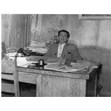

![Storefront of Weingluck's Art Gallery and Gift Shoppe, 665 College Street, Toronto, [ca. 1950]. Ontario Jewish Archives, Blankenstein Family Heritage Centre, item 4461.|](/media/Digital Assets/4461.jpg?width=111&height=111&404=no-img.jpg)
![H. W. Art Gallery, 665 College St., Toronto, [ca. 1948]. Ontario Jewish Archives, Blankenstein Family Heritage Centre, item 4462.|This was the location of Henry Weingluck's first gallery in Toronto. His second store was at 623 College Street, which he opened in the 1950s. He, himself, was a prominent artist, exhibiting in Paris and Berlin before the war.](/media/Digital Assets/4462.jpg?width=111&height=111&404=no-img.jpg)

![N. Hoffman Grocery, 339 Centre Avenue, [ca. 1914]. Ontario Jewish Archives, Blankenstein Family Heritage Centre, item 1556.|This photograph was likely taken on 339 Centre Avenue, before the Hoffman's moved their store to Spadina Avenue in 1915. Pictured are Rivka and Nathan (Nahum) Hoffman.](/media/Digital Assets/1556.jpg?width=111&height=111&404=no-img.jpg)

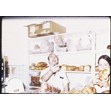
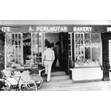

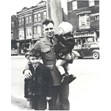
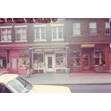







![Bill Gryfe with S. Gryfe and Son's Bakery truck, Toronto, [1933 or 1934]. Ontario Jewish Archives, Blankenstein Family Heritage Centre, item 4520.|](/media/Digital Assets/4520.jpg?width=111&height=111&404=no-img.jpg)
![Arthur Gryfe standing at oven of S. Gryfe and Sons Bakery, 319 Augusta Ave., Toronto, [1931 or 1932]. Ontario Jewish Archives, Blankenstein Family Heritage Centre, item 4519.|Arthur Gryfe was the son of Sam Gryfe. Arthur and his wife Ruth went on to open Gryfe's Bagel Bakery on Bathurst Street in 1957.](/media/Digital Assets/4519.jpg?width=111&height=111&404=no-img.jpg)
![Sam Gryfe with horse-drawn bakery wagon (Hamilton, ON), [ca. 1915]. Ontario Jewish Archives, Blankenstein Family Heritage Centre, item 4517.|This is Sam Gryfe with his horse-drawn bakery wagon, in Hamilton ON.](/media/Digital Assets/4517b.jpg?width=111&height=111&404=no-img.jpg)

![Izzy Shopsowitz and Woody Herman, [197-?]. Ontario Jewish Archives, Blankenstein Family Heritage Centre, fonds 37, series 4, item 44.|Izzy [Isaac] Shopsowitz was co-owner, along with his brother Sam, of Shopsy's Delicatessan. He was a member of Toronto's Beth Tzedec Synagogue. Woody (Woodrow) Charles Herman (1931-1987) was a well-known jazz musician and big band leader.](/media/Digital Assets/37-Gilbert/F37_s4_i044.jpg?width=111&height=111&404=no-img.jpg)

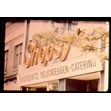
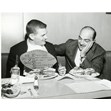
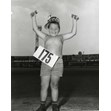
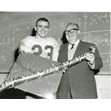

![Milkman Moishe Stern with milk wagon, [ca. 1934]. Ontario Jewish Archives, Blankenstein Family Heritage Centre, fonds 33, series 1, item 22.|](/media/Digital Assets/33-Stern/33-1-22.jpg?width=111&height=111&404=no-img.jpg)

![Joseph Gary's Grocery, 420 College St., Toronto, [ca. 1935]. Ontario Jewish Archives, Blankenstein Family Heritage Centre, item 1543.|](/media/Digital Assets/1543.jpg?width=111&height=111&404=no-img.jpg)

![United Bakers Restaurant, Spadina Ave., Toronto, [between 1925 and 1928]. Ontario Jewish Archives, Blankenstein Family Heritage Centre, fonds 83, file 9, item 35.|Item is a photograph of (left to right) Rose Haniford Green, Sarah Ladovsky, and Mary Haniford Pancer in front of United Bakers Dairy Restaurant. Rose and Mary are sisters and Sarah is their aunt.](/media/Digital Assets/3050.jpg?width=111&height=111&404=no-img.jpg)
![Aaron Ladovsky, Toronto, [ca. 1910]. Ontario Jewish Archives, Blankenstein Family Heritage Centre, fonds 83, file 9, item 9.|Portrait of Aaron Ladovsky in a suit and bowler hat.](/media/Digital Assets/1618.jpg?width=111&height=111&404=no-img.jpg)
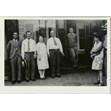
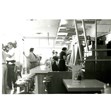
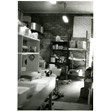
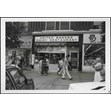
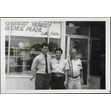
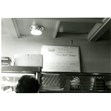

![Looking south on east side of Spadina Ave. north of Dundas St., Toronto, [1947 or 1948]. Ontario Jewish Archives, Blankenstein Family Heritage Centre, item 4034.|This photograph is of Joseph Barsh with his son Preston and his wife Tania. Note the word kosher in Yiddish appears on the signage.](/media/Digital Assets/4034.jpg?width=111&height=111&404=no-img.jpg)
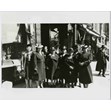

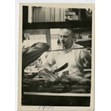
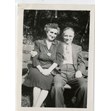


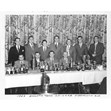
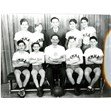
![Y.M.-Y.W.H.A. front desk, Brunswick Avenue, [ca. 1950]. Ontario Jewish Archives, Blankenstein Family Heritage Centre, fonds 61, series 6, item 29.|](/media/Digital Assets/61-JCC/F61_s6_i029.jpg?width=111&height=111&404=no-img.jpg)
![Y.M.-Y.W.H.A. theatre group, [ca. 1950]. Ontario Jewish Archives, Blankenstein Family Heritage Centre, fonds 61, series 6, item 17.|](/media/Digital Assets/61-JCC/F61_s6_i017.jpg?width=111&height=111&404=no-img.jpg)
![Y.M.-Y.W.H.A. exercise room, Brunswick Avenue, [ca. 1950]. Ontario Jewish Archives, Blankenstein Family Heritage Centre, fonds 61, series 6, item 15.|This item is a glass slide of a group of young men lifting weights in the exercise room of the Y.M.-Y.W.H.A. on Brunswick Avenue. The room is visibly overcrowded.](/media/Digital Assets/61-JCC/F61_s6_i015.jpg?width=111&height=111&404=no-img.jpg)
![Y.M.-Y.W.H.A. boys' club, Brunswick Avenue, [ca. 1950]. Ontario Jewish Archives, Blankenstein Family Heritage Centre, fonds 61, series 6, item 25.|This item is a glass slide of a group of members of a Y.M.-Y.W.H.A. boys' club having a discussion while sitting around a table. There is Hebrew writing on the chalkboard behind them.](/media/Digital Assets/61-JCC/F61_s6_i025.jpg?width=111&height=111&404=no-img.jpg)
